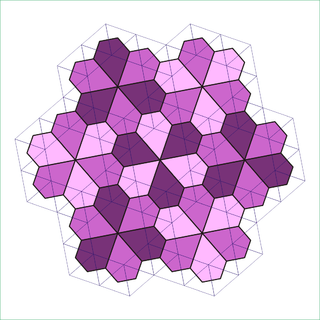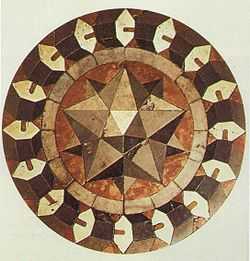Snub trihexagonal tiling
| Snub trihexagonal tiling | |
|---|---|
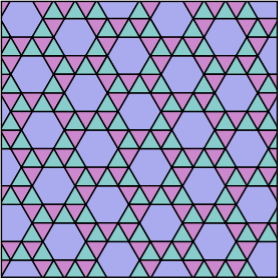 | |
| Type | Semiregular tiling |
| Vertex configuration | 3.3.3.3.6 |
| Schläfli symbol | sr{6,3} |
| Wythoff symbol | | 6 3 2 |
| Coxeter diagram | |
| Symmetry | p6, [6,3]+, (632) |
| Rotation symmetry | p6, [6,3]+, (632) |
| Bowers acronym | Snathat |
| Dual | Floret pentagonal tiling |
| Properties | Vertex-transitive chiral |
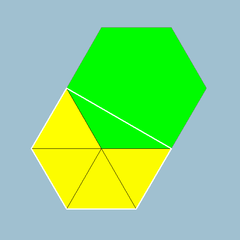 Vertex figure: 3.3.3.3.6 | |
In geometry, the snub hexagonal tiling (or snub trihexagonal tiling) is a semiregular tiling of the Euclidean plane. There are four triangles and one hexagon on each vertex. It has Schläfli symbol of sr{3,6}. The snub tetrahexagonal tiling is a related hyperbolic tiling with Schläfli symbol sr{4,6}.
Conway calls it a snub hexatille, constructed as a snub operation applied to a hexagonal tiling (hexatille).
There are 3 regular and 8 semiregular tilings in the plane. This is the only one which does not have a reflection as a symmetry.
There is only one uniform coloring of a snub trihexagonal tiling. (Naming the colors by indices (3.3.3.3.6): 11213.)
Circle packing
The snub trihexagonal tiling can be used as a circle packing, placing equal diameter circles at the center of every point. Every circle is in contact with 5 other circles in the packing (kissing number). The hexagonal gaps can be filled by exactly one circle, leading to the densest packing from the triangular tiling#circle packing.
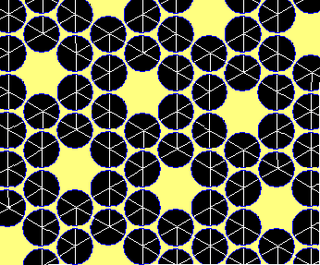
Related polyhedra and tilings
This semiregular tiling is a member of a sequence of snubbed polyhedra and tilings with vertex figure (3.3.3.3.n) and Coxeter–Dynkin diagram ![]()
![]()
![]()
![]()
![]() . These figures and their duals have (n32) rotational symmetry, being in the Euclidean plane for n=6, and hyperbolic plane for any higher n. The series can be considered to begin with n=2, with one set of faces degenerated into digons.
. These figures and their duals have (n32) rotational symmetry, being in the Euclidean plane for n=6, and hyperbolic plane for any higher n. The series can be considered to begin with n=2, with one set of faces degenerated into digons.
| Symmetry n32 [n,3]+ |
Spherical | Euclidean | Compact hyperbolic | Paracompact | ||||
|---|---|---|---|---|---|---|---|---|
| 232 [2,3]+ D3 |
332 [3,3]+ T |
432 [4,3]+ O |
532 [5,3]+ I |
632 [6,3]+ P6 |
732 [7,3]+ |
832 [8,3]+... |
∞32 [∞,3]+ | |
| Snub figure |
 3.3.3.3.2 |
 3.3.3.3.3 |
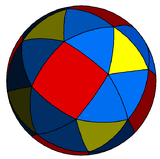 3.3.3.3.4 |
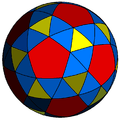 3.3.3.3.5 |
 3.3.3.3.6 |
 3.3.3.3.7 |
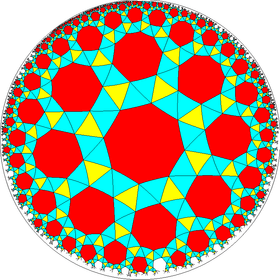 3.3.3.3.8 |
 3.3.3.3.∞ |
| Coxeter Schläfli |
sr{2,3} |
sr{3,3} |
sr{4,3} |
sr{5,3} |
sr{6,3} |
sr{7,3} |
sr{8,3} |
sr{∞,3} |
| Snub dual figure |
 V3.3.3.3.2 |
 V3.3.3.3.3 |
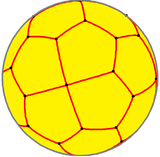 V3.3.3.3.4 |
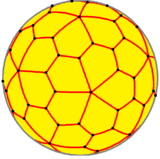 V3.3.3.3.5 |
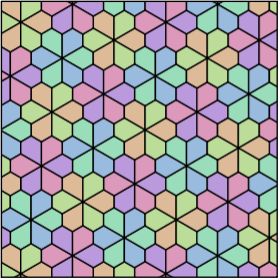 V3.3.3.3.6 |
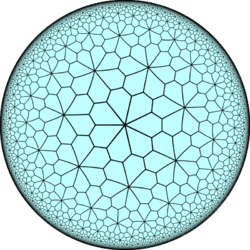 V3.3.3.3.7 |
V3.3.3.3.8 | 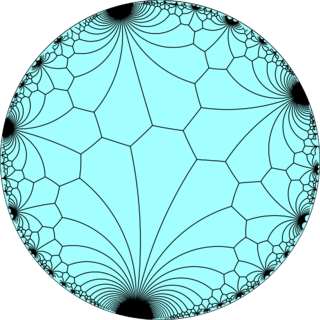 V3.3.3.3.∞ |
| Coxeter | ||||||||
| Symmetry: [6,3], (*632) | [6,3]+ (632) |
[1+,6,3] (*333) |
[6,3+] (3*3) | |||||||
|---|---|---|---|---|---|---|---|---|---|---|
| {6,3} | t{6,3} | r{6,3} r{3[3]} |
t{3,6} t{3[3]} |
{3,6} {3[3]} |
rr{6,3} s2{6,3} |
tr{6,3} | sr{6,3} | h{6,3} {3[3]} |
h2{6,3} r{3[3]} |
s{3,6} s{3[3]} |
= |
= |
= |
= | |||||||
| Uniform duals | ||||||||||
| V63 | V3.122 | V(3.6)2 | V63 | V36 | V3.4.12.4 | V.4.6.12 | V34.6 | V36 | V(3.6)2 | V36 |
Floret pentagonal tiling
| Floret pentagonal tiling | |
|---|---|
 | |
| Type | Dual semiregular tiling |
| Coxeter diagram | |
| Faces | irregular pentagons |
| Face configuration | V3.3.3.3.6 |
| Symmetry group | p6, [6,3]+, (632) |
| Rotation group | p6, [6,3]+, (632) |
| Dual | Snub trihexagonal tiling |
| Properties | face-transitive, chiral |
In geometry, the floret pentagonal tiling is a dual semiregular tiling of the Euclidean plane. It is one of 14 known isohedral pentagon tilings. It is given its name because its six pentagonal tiles radiate out from a central point, like petals on a flower.[1] Conway calls it a 6-fold pentille.[2] Each of its pentagonal faces has four 120° and one 60° angle.
It is the dual of the uniform tiling, snub trihexagonal tiling,[3] and has rotational symmetry of orders 6-3-2 symmetry.
See also
| Wikimedia Commons has media related to Uniform tiling 3-3-3-3-6. |
- Tilings of regular polygons
- List of uniform tilings
References
- ↑ Five space-filling polyhedra by Guy Inchbald
- ↑ John H. Conway, Heidi Burgiel, Chaim Goodman-Strass, The Symmetries of Things 2008, ISBN 978-1-56881-220-5 (Chapter 21, Naming Archimedean and Catalan polyhedra and tilings, p288 table)
- ↑ Weisstein, Eric W., "Dual tessellation", MathWorld.
- John H. Conway, Heidi Burgiel, Chaim Goodman-Strass, The Symmetries of Things 2008, ISBN 978-1-56881-220-5
- Grünbaum, Branko ; and Shephard, G. C. (1987). Tilings and Patterns. New York: W. H. Freeman. ISBN 0-7167-1193-1. (Chapter 2.1: Regular and uniform tilings, p. 58-65)
- Williams, Robert (1979). The Geometrical Foundation of Natural Structure: A Source Book of Design. Dover Publications, Inc. ISBN 0-486-23729-X. p. 39
External links
- Weisstein, Eric W., "Uniform tessellation", MathWorld.
- Weisstein, Eric W., "Semiregular tessellation", MathWorld.
- Richard Klitzing, 2D Euclidean tilings, s3s6s - snathat - O11
| ||||||||||||||||||||||||||||||||||||||||||||||||||||||||||
